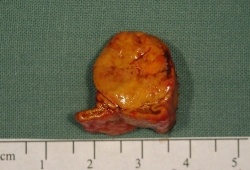Resumo
Definição
História e exame físico
Principais fatores diagnósticos
- hipertensão
- presença de fatores de risco
Outros fatores diagnósticos
- idade entre 20 e 70 anos
- noctúria, poliúria
- letargia
- distúrbios de humor (irritabilidade, ansiedade e depressão)
- dificuldade de concentração
- parestesias, cãibras musculares
- fraqueza muscular
- palpitações
Fatores de risco
- história familiar de AP
- história familiar de início precoce de hipertensão e/ou AVC
Investigações diagnósticas
Primeiras investigações a serem solicitadas
- potássio plasmático
- relação aldosterona/renina
Investigações a serem consideradas
- teste de carga oral de sal
- teste de infusão de soro fisiológico
- teste genético
- tomografia computadorizada (TC) da adrenal
- amostragem da veia adrenal
- ressonância nuclear magnética (RNM) adrenal
- teste de estimulação de postura
- teste de infusão de angiotensina II
- esteroides híbridos urinários de 24 horas (18-hidroxi e 18-oxocortisol)
- teste de supressão de dexametasona
Novos exames
- PET-CT com ¹¹ C-metomidato
Algoritmo de tratamento
aldosteronismo primário (AP) unilateral
AP bilateral (excluindo hiperaldosteronismo familiar tipo I)
hiperaldosteronismo familiar tipo I
Colaboradores
Autores
Michael Stowasser, MBBS, FRACP, PhD

Professor
Endocrine Hypertension Research Centre
University of Queensland Frazer Institute
Greenslopes and Princess Alexandra Hospitals
Brisbane
Queensland
Australia
Declarações
MS is an author of several references cited in this topic.
Agradecimentos
Professor Michael Stowasser would like to gratefully acknowledge Professor Richard D. Gordon, a previous contributor to this topic.
Revisores
Paolo Mulatero, MD
Department of Medicine and Experimental Oncology
Division of Medicine and Hypertension
San Giovanni Battista Hospital
Torino
Italy
Declarações
PM declares that he has no competing interests.
Wail Malaty, MD
Clinical Professor
Department of Family Medicine
University of North Carolina
Chapel Hill
Assistant Program Director
MAHEC Rural Family Medicine Residency
Hendersonville
NC
Declarações
WM declares that he has no competing interests.
Créditos aos pareceristas
Os tópicos do BMJ Best Practice são constantemente atualizados, seguindo os desenvolvimentos das evidências e das diretrizes. Os pareceristas aqui listados revisaram o conteúdo pelo menos uma vez durante a história do tópico.
Declarações
As afiliações e declarações dos pareceristas referem--se ao momento da revisão.
Referências
Principais artigos
Mulatero P, Sechi LA, Williams TA, et al. Subtype diagnosis, treatment, complications and outcomes of primary aldosteronism and future direction of research: a position statement and consensus of the Working Group on Endocrine Hypertension of the European Society of Hypertension. J Hypertens. 2020 Oct;38(10):1929-36. Resumo
Reincke M, Bancos I, Mulatero P, et al. Diagnosis and treatment of primary aldosteronism. Lancet Diabetes Endocrinol. 2021 Dec;9(12):876-92. Resumo
Funder JW, Carey RM, Mantero F, et al. The management of primary aldosteronism: case detection, diagnosis, and treatment: an Endocrine Society clinical practice guideline. J Clin Endocrinol Metab. 2016 May;101(5):1889-916.Texto completo Resumo
Young WF Jr. Diagnosis and treatment of primary aldosteronism: practical clinical perspectives. J Intern Med. 2019 Feb;285(2):126-48.Texto completo Resumo
Artigos de referência
Uma lista completa das fontes referenciadas neste tópico está disponível para os usuários com acesso total ao BMJ Best Practice.

Diagnósticos diferenciais
- Hipertensão essencial
- Hipocalemia induzida por tiazida em pacientes com hipertensão essencial
- Estenose da artéria renal
Mais Diagnósticos diferenciaisDiretrizes
- NCCN clinical practice guidelines in oncology: neuroendocrine and adrenal tumors
- Japan Endocrine Society clinical practice guideline for the diagnosis and management of primary aldosteronism 2021
Mais DiretrizesConectar-se ou assinar para acessar todo o BMJ Best Practice
O uso deste conteúdo está sujeito ao nosso aviso legal